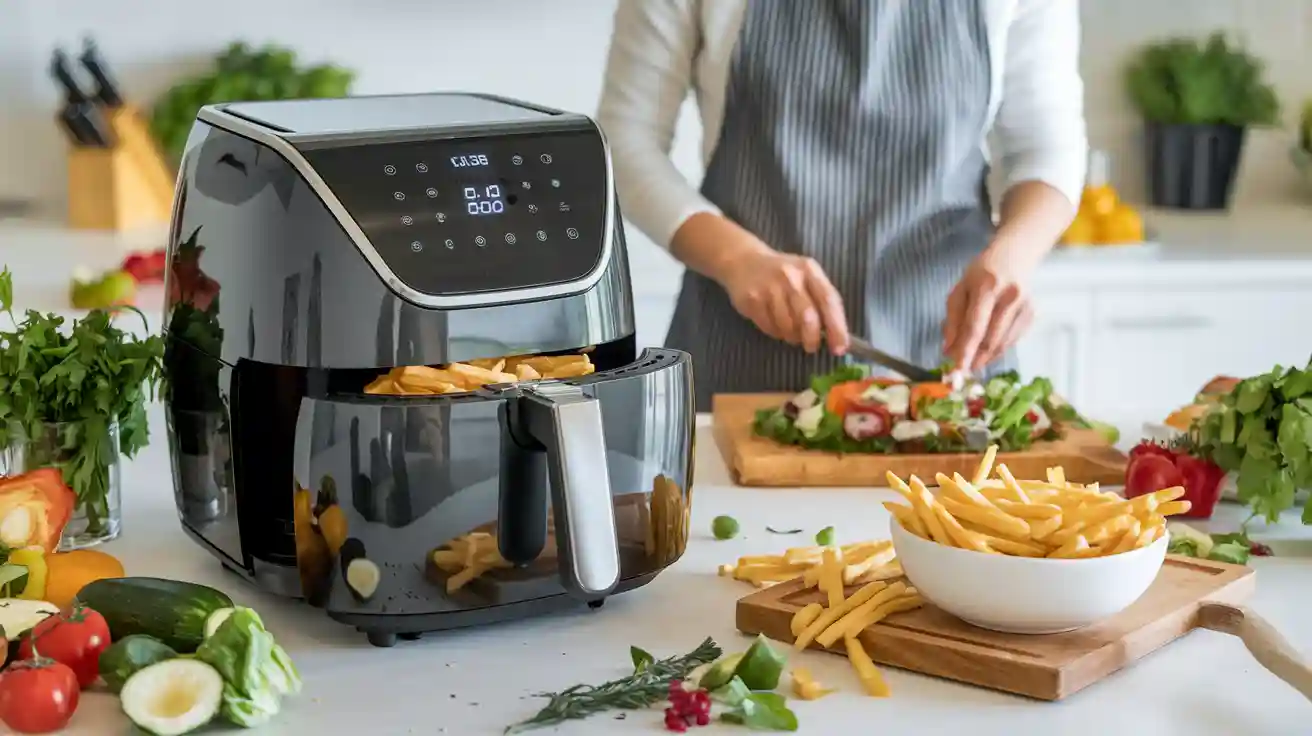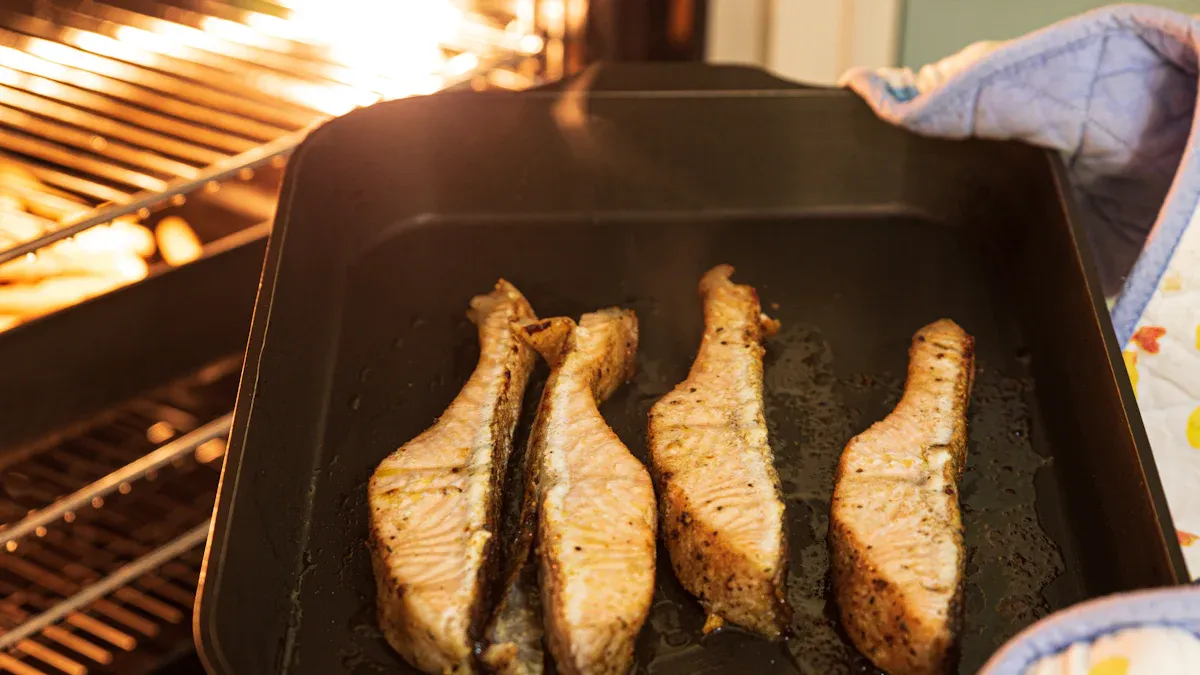
Do you love fried food but worry about the health risks? An air fryer could be your new best friend! Air frying uses up to 75% less fat than traditional frying, helping you enjoy crispy meals guilt-free. Plus, it cuts harmful acrylamides by 90%, making it a safer option for your family.
How Air Fryers Work
The Science of Air Frying
Ever wondered how air fryers create that crispy, golden perfection without dunking your food in oil? It all comes down to hot air and a little bit of science. Air frying uses rapid air circulation to cook food evenly. A powerful fan blows hot air around the food, creating a convection effect. This process mimics the results of deep frying but with significantly less oil.
Here’s a closer look at the principles behind air frying:
| Principle/Mechanism | Description |
|---|---|
| Cooking Process | Air frying uses hot air with oil droplets to cook food, promoting uniform contact and reducing oil usage. |
| Health Benefits | Results in lower fat and calorie content in food, contributing to health advantages. |
| Environmental Impact | Reduces fuel consumption and emissions compared to traditional frying methods. |
| Oil Absorption | Can reduce oil absorption by up to 90%, leading to healthier food options. |
| Cooking Efficiency | The process is faster than conventional frying due to high air velocity and circulation. |
This combination of speed and efficiency makes air frying a game-changer for health-conscious cooks like you. Plus, it’s not just about frying—you can bake, roast, and even grill with some models.
Key Features of Air Fryers
When you’re shopping for an air fryer, you’ll notice they come packed with features designed to make cooking easier and healthier. Here are some of the standout features you should know about:
- Rapid Air Technology: This is the heart of every air fryer. It ensures your food cooks quickly and evenly.
- Temperature Control: Most air fryers let you adjust the temperature, giving you control over how crispy or tender your food turns out.
- Preset Cooking Programs: Many models include presets for popular dishes like fries, chicken, and vegetables. These take the guesswork out of cooking.
- Non-Stick Coating: Cleaning up is a breeze thanks to non-stick baskets and trays.
- Compact Design: Air fryers are small enough to fit on your countertop but large enough to cook for the whole family.
In recent years, air fryers have become even more advanced. You’ll find models with digital displays, app controls, and even voice activation. Some can do more than just fry—they can grill, roast, bake, and dehydrate. These multifunctional features make air fryers a versatile addition to your kitchen.
Air Fryers vs. Traditional Frying Methods
So, how do air fryers stack up against traditional frying methods? Let’s break it down:
- Health Benefits: Air frying uses up to 75% less oil than deep frying, which means fewer calories and less fat in your meals. Plus, air-fried foods contain fewer harmful compounds like acrylamides.
- Energy Efficiency: Studies show that air fryers are more energy-efficient than traditional frying methods. They cook food faster, saving both time and electricity.
- Taste and Texture: In a sensory evaluation, participants ranked air-fried chicken highly for taste, aroma, and texture. While it may not be as greasy as deep-fried food, it still delivers on flavor.
- Convenience: Air fryers are easier to use and clean. There’s no need to deal with large amounts of hot oil, making them safer and more convenient.
With all these advantages, it’s clear why air fryers have become so popular. They offer a healthier, faster, and more sustainable way to enjoy your favorite fried foods.
Health Benefits of Air Frying
Lower Fat and Calorie Content
If you’re looking to cut back on fat and calories without sacrificing flavor, air frying is a fantastic option. Traditional deep frying often requires large amounts of oil, which can significantly increase the calorie content of your meals. Air fryers, on the other hand, use little to no oil while still delivering that crispy, golden texture you love.
Here’s how air frying helps reduce fat and calories:
- Air frying can lower calorie intake by 70% to 80% compared to deep frying.
- Most air fryers only need about 1 teaspoon of oil, which adds just 42 calories. In contrast, deep frying with 1 tablespoon of oil adds around 126 calories.
By using less oil, you’re not only cutting calories but also reducing the amount of unhealthy fats in your diet. This makes air-fried foods a healthier alternative for anyone trying to manage their weight or improve their overall eating habits.
Preserving Nutritional Value
Did you know that air frying can help retain more nutrients in your food compared to traditional frying? When you deep fry vegetables, the high heat and oil can strip away essential vitamins and minerals. Air frying avoids this problem by using hot air instead of oil to cook your food.
Here’s why air frying is better for preserving nutrients:
- It retains important vitamins and minerals in foods, especially in vegetables.
- Unlike deep frying, air frying doesn’t soak your food in oil, which can degrade its nutritional value.
For example, air-fried vegetables maintain their natural flavors and nutrients, making them a great choice for health-conscious cooks. Whether you’re preparing broccoli, carrots, or zucchini, you can enjoy their full nutritional benefits without worrying about losing key vitamins during the cooking process.
Comparing Air Frying to Other Cooking Methods
You might be wondering how air frying stacks up against other popular cooking methods like baking or steaming. While each method has its benefits, air frying stands out for its ability to combine health benefits with convenience and flavor.
Here’s how air frying compares:
- It uses significantly less oil than deep frying, which means fewer calories and less fat.
- Air frying reduces harmful compounds like acrylamide, which are often found in deep-fried foods.
- Compared to baking, air frying is faster and can produce a crispier texture without drying out your food.
- Steaming is great for preserving nutrients, but it doesn’t offer the same crispy texture that air frying provides.
Air frying strikes a balance between health and taste. It’s a lower-calorie cooking method that still delivers satisfying results, making it a versatile choice for a wide range of dishes. Plus, it’s safer and more convenient than dealing with large amounts of hot oil.
Choosing the Right Air Fryer
Basket-Style vs. Oven-Style Air Fryers
When choosing an air fryer, you’ll often come across two main types: basket-style and oven-style. Each has its strengths, so the right choice depends on your cooking needs.
Basket-style air fryers are compact and easy to use. They come with a pull-out basket, making them perfect for tossing or shaking foods like fries or chicken wings. These models are great for smaller meals and quick snacks. On the other hand, oven-style air fryers offer more cooking functionality. They have multiple trays, which means you can cook larger portions or different foods at the same time. However, you might need to rotate the trays to ensure even cooking.
Consumer Reports highlights that basket-style models excel in simplicity, while oven-style air fryers shine when cooking for a crowd. For example, the PowerXL Maxx is a popular oven-style option that performs well in tests for crispiness and juiciness.
Features to Consider (Size, Presets, Wattage)
Before buying an air fryer, think about the features that matter most to you. Size is a big one. If you’re cooking for one or two people, a smaller model will do. But for families, a larger capacity is better.
Presets can make your life easier. Many air fryers come with pre-programmed settings for popular dishes like fries, chicken, and vegetables. These take the guesswork out of cooking. Wattage is another factor to consider. Higher wattage means faster cooking, but it also uses more electricity.
Here’s a quick comparison of some popular models:
| Model | Capacity | Presets | Wattage |
|---|---|---|---|
| Food Electric Air Fryer | 6 quarts | 6 options | N/A |
| Ninja Max XL | 6.5 quarts | 6 cooking modes | N/A |
Best Air Fryers for Healthy Cooking
If you’re looking for the best air fryers for healthy cooking, focus on models that deliver consistent results with minimal oil. The Ninja Max XL is a standout choice. It offers a large capacity, multiple presets, and excellent performance for air-fried foods. Another great option is the Philips Premium Airfryer XXL, known for its even cooking and easy-to-clean design.
When picking an air fryer, think about how it fits into your lifestyle. Whether you want a simple basket-style model or a feature-packed oven-style option, there’s something out there for everyone.
Healthy Foods to Cook in an Air Fryer

Nutrient-Rich Air Fryer Recipes
Air fryers are perfect for preparing nutrient-packed meals that taste amazing. You can whip up crispy kale chips, roasted chickpeas, or even sweet potato fries with just a touch of oil. These snacks are not only delicious but also loaded with vitamins and fiber. For a protein boost, try air-frying salmon or chicken breast. The hot air locks in moisture while giving the outside a golden, crispy finish.
Vegetables like broccoli, zucchini, and carrots also shine in air fryer recipes. They retain their natural flavors and nutrients while developing a satisfying crunch. Toss them with a little olive oil and your favorite spices, and you’ve got a side dish that’s both healthy and irresistible.
Foods to Avoid in Air Fryers
While air fryers are versatile, some foods don’t work well in them. Avoid cooking foods with wet batters, like tempura or beer-battered fish. The batter can drip through the basket and create a mess. Cheese on its own is another tricky ingredient. It melts quickly and can stick to the basket, making cleanup a hassle.
Leafy greens, unless coated in oil, can fly around due to the strong air circulation. Also, steer clear of foods that require a lot of liquid, like soups or stews. These are better suited for other cooking methods.
Creative Meal Ideas for Health-Conscious Cooks
Looking for inspiration? Use your air fryer to make stuffed bell peppers filled with quinoa and veggies. Or try air-fried tofu cubes for a plant-based protein option. Craving dessert? Slice up some apples, sprinkle them with cinnamon, and air-fry them for a quick and healthy treat.
You can even experiment with global flavors. Make falafel, spring rolls, or even samosas with minimal oil. The possibilities are endless, and your air fryer can help you explore them all while keeping your meals nutritious and flavorful.
Tips for Healthy Air Fryer Cooking
Preparing Ingredients for Air Frying
Getting your ingredients ready the right way can make a big difference in how your air-fried dishes turn out. Start by preheating your air fryer. This step ensures even cooking and prevents overcooking. When loading the basket, avoid overcrowding it. Giving your food enough space allows the hot air to circulate properly, making everything crispy instead of soggy.
For starchy foods like potatoes, blanching them before air frying can help reduce acrylamide formation, a compound linked to health risks. Also, choose oils with high smoke points, like vegetable or grapeseed oil, for better results. Extra-virgin olive oil isn’t ideal because it can burn at high temperatures. These small adjustments can elevate your cooking techniques and make your meals healthier.
Using Minimal Oil and Seasoning
One of the best things about air fryers is that you don’t need much oil. A light spray or a teaspoon is usually enough to get that golden, crispy texture. For seasoning, stick to dry spices and herbs. Wet marinades can drip and create a mess. Toss your ingredients with the seasoning before cooking to ensure every bite is flavorful.
Cleaning and Maintaining Your Air Fryer
Keeping your air fryer clean is key to maintaining its performance. After each use, wash the basket and tray with warm, soapy water and a non-abrasive sponge. This prevents grease and food residue from building up. Once a month, do a deep clean using a mix of water and vinegar or baking soda. Inspect the nonstick coating regularly and avoid using harsh tools that could damage it. A clean air fryer not only lasts longer but also keeps your food tasting fresh.
Air fryers are more than just a trendy kitchen gadget—they’re a healthier way to enjoy your favorite meals. By reducing oil consumption to as low as 5%, they promote better eating habits while saving energy. With trusted brands like Ninja leading the way, you can confidently explore this cooking method to create nutritious, flavorful dishes.
FAQ
How much oil should I use in an air fryer?
You only need about 1 teaspoon of oil for most recipes. A light spray works too. This keeps your meals crispy and low in fat.
Can I cook frozen foods in an air fryer?
Absolutely! Air fryers handle frozen foods like fries, nuggets, and veggies perfectly. Just adjust the cooking time and temperature based on the package instructions.
Do air fryers make food taste like deep-fried dishes?
Not exactly, but close! Air fryers create a crispy texture without the greasiness. You’ll enjoy a healthier version of your favorite fried foods with great flavor.
💡 Tip: Experiment with seasonings and coatings to enhance the taste and texture of air-fried dishes!


